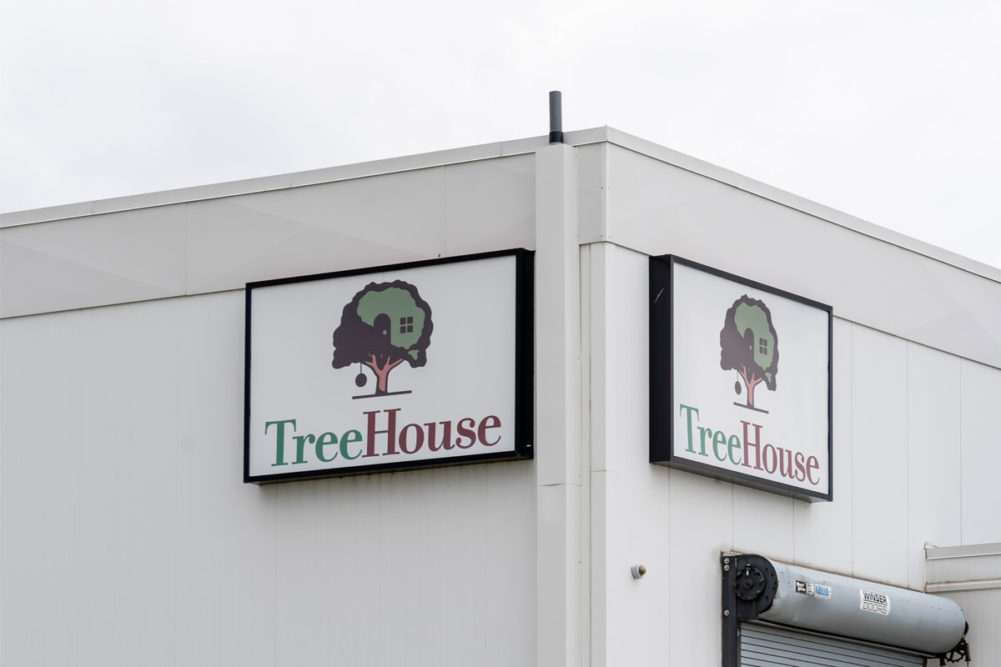OAK BROOK, ILL. — During an Aug. 8 conference call with securities analysts to discuss second-quarter results, private label food and beverage maker TreeHouse Foods, Inc. reasserted its intention to divest a “significant portion” of its meal preparation segment in favor of its snacking and beverage unit.
“We continue to work very diligently to reshape the TreeHouse portfolio through a divestment of a significant portion of our meal prep business so that we can build leadership and depth around a focused group of categories in our higher growth snacking and beverage businesses,” said Steven T. Oakland, president and chief executive officer.
Investors responded positively to the company’s second-quarter results. In early morning trading on Aug. 8, TreeHouse’s stock price hit $46.54 per share, a 9% increase from the Aug. 7 close of $42.68 per share.
TreeHouse sustained a loss of $29.4 million in the second quarter ended June 30, which compared with net income of $8.4 million, equal to 15¢ per share, in the same period a year ago. Adjusted EBITDA from continuing operations, meanwhile, was $66.5 million, down 28% from $92.6 million in the same period a year ago.
TreeHouse net sales in the second quarter were 1.19 billion, up 19% from $1 billion for the same period last year. The sales increase was primarily driven by favorable pricing to recover commodity and freight cost inflation as well as increased volume in the snacking and beverage business segment, the company said.
“We posted strong revenue growth, up 19.4% to $1.2 billion,” said Patrick M. O’Donnell, chief accounting officer, who was named interim chief financial officer of TreeHouse in June.
“Pricing drove 17.7% of the growth, while volume rose 2.1%, offset by 48 basis points of foreign exchange,” Mr. O’Donnell said. “Our ability to capture growing incremental volume across several categories within snacking and beverages, in particular, has been encouraging.”
Direct operating income in the TreeHouse Meal Preparation segment was $56 million, down 14% from $65.2 million in the same period of fiscal 2021. Quarterly sales were $766 million, up 18% from $648 million in 2021. The increase in sales was primarily attributed to pricing, and partially offset by lower volume because of labor and supply chain constraints, the company said.
Direct operating income in the Snacking and Beverage business increased 5% to $38.8 million from $36.9 million. Snacking and Beverage business unit sales in the second quarter were $432 million, up 21% from $356 million in the second quarter of 2021.
“Increasing private label demand resulted in strong category performance as the consumer seeks lower priced alternatives in the inflationary environment,” the company said. “However, volume growth was partially muted due to labor and supply chain disruption.”
Mr. Oakland said supply chain disruptions were less severe in the company’s snacking and beverage segment than in its meal preparation segment. He also emphasized higher demand in snacking and beverages with consumers spending more time away from home.
“As the economy has opened up, much of the snacking and beverage mix is those on-the-go items,” he said.
As inflation drives shelf prices higher, private label is gaining momentum, Mr. Oakland said.
“The combination of high shelf prices and high-priced gas translates into a dollar savings for a basket of private label goods that has never been greater,” he said. “You can see that the pandemic related trends of the past two years actually began to reverse this year, and that private label gains have been accelerating since March.”
Mr. O’Donnell added perspective.
“History would tell you that during periods of economic downturn, private label gains trial, new consumers and, as a result, share increases,” he said. “Historically, these periods have been step changes for private label. Today private label is positioned significantly better than in past periods of economic downturn.
“First, the quality and assortment of private label has improved dramatically. The number of options now include a spectrum from natural and organic to national brand equivalent to value offerings.
“And second, the retail landscape has also changed dramatically. Growth in terms of number of outlets has been driven in a large part by private label focused discount retailers. Today, there are also retailers whose private label programs not only drive traffic but play a key role in their store image.”
Mr. Oakland added, “Overall, I’m encouraged with our progress and I believe that we are very much on track and continue to improve service and profitability throughout the year as we begin to enter our seasonal peak. We are effectively managing inflation with pricing, collaborating with our customers and executing on our efforts to drive cost savings across the network.”




